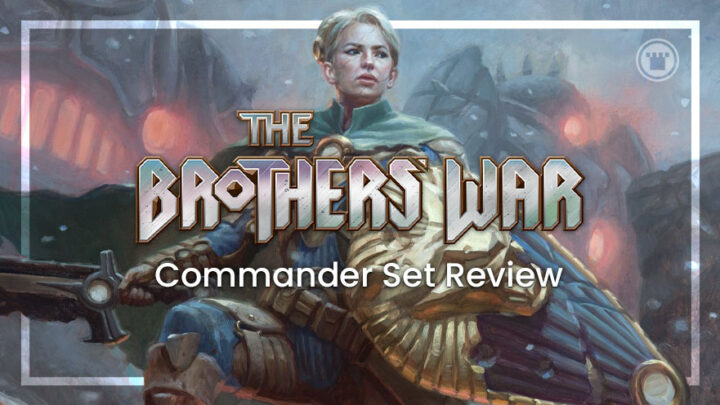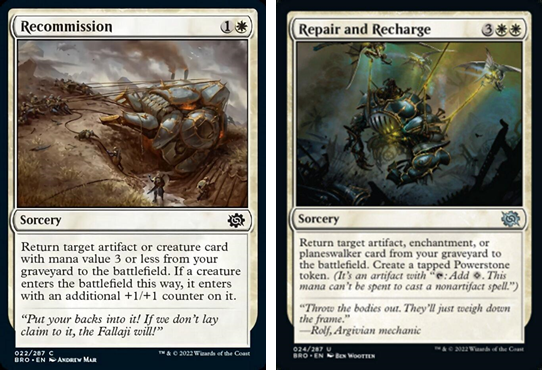It’s time to dig into The Brother’s War, a nostalgia-packed flashback to the struggles of Urza, Mishra and the Phyrexians. For older players it’s a treat, and newer players can finally experience a classic Magic story. But what does The Brothers’ War offer Commander players?
BRO — and yes, that’s the set code — is a veritable smash hit for Commander, with plenty of staples. It’s an artifact set, so there’s guaranteed to be something for everyone. Today, I’ll review the highlights of the set for Commander.
And remember, If you like what you see, you can find other recent set reviews here:
- Dominaria United
- Battle for Baldur’s Gate
- Streets of New Capenna
- Kamigawa: Neon Dynasty
- Crimson Vow and Midnight Hunt
With that out of the way, let’s begin.
BROTHER’S WAR: WHITE
Calamity’s Wake kind of starts us at the end. Urza’s Sylex heralds an ice age on Dominaria. It’s also a way to manipulate the opponent, putting them on ice for the turn.
To add icing to the cake, it also exiles graveyards, interrupting many combo synergies. I expect this to make waves in competitive Commander.
Great Desert Prospector isn’t quite the white Dockside Extortionist, but it’s doing a reasonable impression. GDP raises your gross mana production, as long as it’s spent on artifact spells. This goes some way to reign it in, but I can still imagine the right decks loving this five mana ritual.
I love some card advantage in white, and Kayla’s Reconstruction is one worth a look — especially if you can manipulate your top deck. Scroll Rack, Reinforcements and the like can give you a solid way to make this work.
Is it worth the squeeze? I think, given it can also put artifacts into play, it could be.
While Lay Down Arms isn’t quite Swords to Plowshares, Path to Exile or Winds of Abandon, it is a one mana removal spell that doesn’t give an opponent resources.
While the Plains count effectively time gates its effectiveness, you’re usually going to be able to get rid of what you need to if you build your mana base properly — especially given all of the new ways to grab Plains, like Archaeomancer’s Map.
I like Lay Down Arms quite a bit, and I’d encourage you to not ignore it just because it’s sorcery speed.
They did it guys — they finally did it. We got our white Reclamation Sage! No wonder Feldon fell in love with her; Loran of the Third Path is a stellar offering.
As she’s legendary, she comes with a few bells and whistles. First up, she has Vigilance. But perhaps more importantly, she has a semi-parley ability, giving you and an opponent you choose the opportunity to draw a card.
This will be a great political tool. I’m very excited to add Loran to my decks.
Loran also has another card: Disciple of History. It comes with a repeatable enters-the-battlefield trigger to return artifacts to hand from the bin. This is likely to see play in decks as diverse as Tameshi, Teshar and Osgir.
Not every set has a card that combos with Dockside Extortionist, but Brother’s War does. Meticulous Excavation lets you bounce Dockside to your heart’s content.
This enchantment is sure to be overshadowed by that one interaction, so maybe bring up pre-game whether people need to be afraid of it or not. Outside of combos, this is a fine way to reuse EtB effects, and if you really want to, play with unearth in Orzhov or Abzan.
White has some real smash-hits in BRO, and Myrel, Shield of Argive is one of them. The love child of Grand Abolisher and Adeline, Resplendent Cathar, Myrel is damned cool, has amazing Ryan Pancoast art and will be a roleplayer going forward in decks that love some Grand Abolisher action. Just watch out, as ever, for opponents cloning it.
Next up, a pair of cool recursion spells. Recommission might seem a little pedestrian, but the real indicator of whether you’ll want this one is if your Commander costs three mana or less. Two mana to bring back your Commander, bigger, with the option to bring back friends instead? Or even your best equipment? That’s sweet. It really is.
Repair and Recharge, meanwhile, iterates on Beacon of Unrest… sort of. There’s flexibility here, for five mana, and giving you a little extra mana for your troubles helps massage that chunky upfront cost. It’s not a card I’d run everywhere, but it’s firmly playable.
It wouldn’t be a 2022 Magic set without white card draw. Tocasia’s Welcome gives you a card the first time a mana value three or less creature enters under your control each turn.
There are plenty of decks that love this effect (Adeline, Krav & Regna and Edgar Markov immediately spring to mind), and I’m sure there’s at least one deck in your collection that would enjoy playing it. The fact that it triggers off of tokens, too, is welcome.
Not content to stop at one white draw effect, BRO also brings us Platoon Dispenser. Like a military Pez, it pops out cards at the end of your turn if you control two or more other creatures, which isn’t too shabby.
Making tokens and unearthing is pretty nice, too, I guess. Ultimately, it’s five mana, so it’s gonna be better in low to the ground builds as a curve topper.
There’s a lot to like in BRO, bro, and Steel Seraph is right up my street. For I, and anyone else playing tribal angels, Steel Seraph is a funky inclusion.
I’ll probably cast this as a prototype most of the time… really, the actual mana value is kinda “Kicker.” It’s a miniature Angelic Skirmisher effect and I can’t wait to play with it.
See, I’m not sure about Urza’s Sylex. But given it blows up lands, it bears a mention in a set review.
Now, since we’ve already seen a lot of support for low-to-the ground decks this set, it’s easy to see Sylex as a tool for that archetype, to be used once they have a lead. For that to bear fruit, you also need a way to stop your board from disappearing into the ether, too.
I think it’s a good card, but you need to be combining it with the likes of Cosmic Intervention to really feel like it’s worthwhile in the 99.
BROTHER’S WAR: BLUE
Defabricate is an exciting counterspell, which feels like an oxymoron. It feels very playable in Commander, especially if your friends love Theros gods, enchantress or artifact based decks.
It’s definitely playing second fiddle to hard counters, or Swan Song, but the card feels like it can fit in as option three to four.
So you’re telling me we just need to turn Dockside Extortionist into an artifact…?
I’m already tired of that joke, so I can bet you are too. Drafna, Founder of Lat-Nam, is thankfully way more interesting than that, and could easily helm a deck or find plenty of work in the 99. He is still a potential combo piece, though.
I love cards that reward playing mono-color decks, and Flow of Knowledge is a solid entry for this type of card. It draws plenty of cards at the cost of discarding two.
I’m not sure why you wouldn’t play this in a mono blue deck, as long as your mana generation was on point.
They’re never going to print a card like Cyclonic Rift again, but this comes close. Hurkyl’s Final Meditation is an instant speed Devastation Tide that also ends the turn.
It does cost a whopping 10 mana to cast in an opponent’s turn, though, which feels more than fair. This feels like a real control card. The average deck will probably fair fine with Cyclonic Rift.
Controlling an artifact creature isn’t the highest hurdle, especially with the likes of Esper Sentinel running around. Machine Over Matter is a card that seems slated for artifact creature based decks, but will potentially see some breakout play in cEDH depending on the density of low drop playable artifact creatures.
Ah, a nice curve topper for Simic lands decks. I kid, because those decks already have plenty of win conditions…
At the same time, they’re the only ones capable of fronting the mana for a card like One with the Multiverse. It’s going to need either lands or treasures to support it, but it’ll definitely win games.
Skystrike Officer is the poster child for “solid tribal support.” It’s evasive, it makes tribal tokens and it lets you draw cards.
The only baffling thing is that it’s blue rather than white or Boros. I guess we’re in Azorius for soldiers now.
Splitting the Powerstone is an interesting ramp spell. Provided you’re in a deck casting a lot of artifact spells, it allows you to turn something forgettable into a Sol Ring, essentially.
Getting to draw a card sometimes will feel great, as will setting up recursion plays around the graveyard. It starts to get silly when you include token doubling.
Stern Lesson is an instant speed Divination, and for that reason alone, it’s already kinda playable. Setting up the graveyard while generating token mana rocks? Even better.
It’s a pretty basic common, but that doesn’t mean it isn’t going to show up in decks.
Teferi, Temporal Pilgrim is one of our walkers from the set. Growing loyalty when you draw cards means he will be pretty hard to get rid of, especially given he can make a blocker that grows with him.
His ultimate is pretty brutal, and I can see it being a way to slow down players who pull ahead, much like River’s Rebuke. He’ll find a home in decks like Minn, Wily Illusionist.
Urza’s Command falls on the curve at that awkward spot: four mana for an instant. To be playable, it has to be pretty good.
Well, the most regular use case is you get to make a blocker or a mana rock while drawing a card. I don’t think that’s game-breakingly-good, so I think this card will settle into particular builds that care about Constructs.
Arcane Proxy is not Snapcaster Mage. It is, however, a very flickerable target for an Ephemerate or Momentary Blink, and that’s something worth brewing around. I think this card is a trap if you’re not out to flicker it, but as soon as you are, it’s very, very good.
Hulking Metamorph is another one that’s pretty okay up front, but it gets way better if your deck is built around blinking creatures in and out of play (or the graveyard, I guess). Prototype is essentially reverse Kicker, and it lets you have a late game mana sink to get a beefier creature.
The card isn’t as strong as Phyrexian Metamorph, but it will see play alongside it in the right build.
The Temporal Anchor is just weird, and for that reason alone, it’ll see play. Is it good? I think so, but you need to be leaning pretty hard into build-around territory.
As an aside, is it me, or does this particular piece of tech look Kaladeshi?
Terisian Mindbreaker is a mill player’s dream, and who am I to quash their hope? It has the magic words “half their library,” which equates to their full library when paired with other effects.
It’s brutal, but pretty niche.
BROTHERS WAR: BLACK
Battlefield Butcher kinda looks like he strayed over from the Warhammer 40k decks, doesn’t he? While a great draft win condition, I think he’s also playable in EDH.
Rakdos decks that churn through permanents will love this as an enabler for Spectacle or casting Rakdos, Lord of Riots.
Disciples of Gix may seem a little pricey, but it’s definitely going to be used as a combo enabler. And for that reason, having it cost six mana is probably for the best.
Unearth and reanimator decks will rejoice at such a card, and it’ll be played alongside Buried Alive for sure. Except in this case, it’s Buried… Inert.
Gix, Yawgmoth Praetor is a Praetor, which is kinda cool. I hadn’t imagined seeing Praetors outside of the ”Big Five,” and certainly not one of this power level. Three mana for a card draw engine is excellent, even if it is able to fuel opponents. It’s worth it to control the ebb and flow of combat.
The mana sink is honestly… well, if it is gravy, it’s more like a demi-glace. The discard cost isn’t that high when you can draw a bunch off of Gix as is.
I love a good mini-game card, and Hostile Negotiations is one I want to play as often as I can. At its base rate, this is better than three cards for four mana. The other three cards end up in the graveyard, which for a lot of decks, is the equivalent of drawing six cards in total.
I’m gonna grab a playset of these.
Overwhelming Remorse hearkens back to Murderous Cut. While some decks still love the Delve mechanic — and can happily fuel it — there are others that don’t want to exile the graveyards.
For those decks, they can exile an opposing creature for as low as one black mana. This is a sweet removal spell I’d be happy to play.
There are a lot of combo pieces in this set, and Thran Vigil is one that’ll put a feather in your cap. Any creature you want to loop that has Persist can be looped indefinitely with this enchantment in play.
Whether that’s keeping Glen Elendra Archmage around, gaining infinite life with Kitchen Finks or just murdering someone with Murderous Redcap, you’ll be sure to find a use for Thran Vigil.
Phyrexian Fleshgorger is a bit overrated, but only until the game starts to go long. The life swing from attacking with Wurmcoil Engine is massive, and Fleshgorger can arguably do it more efficiently. It doesn’t leave behind tokens, though, so it is a little less resilient.
Razorlash Transmogrant is honestly pretty great. Plenty of decks want to recur creatures for cheap, and getting this down to just BB to recur won’t be difficult.
The fact that this is also a zombie makes it even more enticing. I expect to see this played in plenty of aristocrat and zombie tribal decks.
Hey, it’s a fixed Skullclamp. Transmogrant’s Crown is pretty reasonable if you want card draw, but it does require you to jump through a few hoops. It’s obviously not as good as its predecessor, but nothing will ever come close.
BROTHERS WAR: RED
Arms Race is going to excite all of the Purphoros, Bronze-Blooded players out there. It’s a redundant effect that you want in the deck anyways, so what’s not to love?
Outside of those specific “sneaky” decks, Arms Race will see some amount of play too, especially as it isn’t limited to only creatures.
When Boros enchantress eventually becomes a deck, Bitter Reunion will be an early staple. As is, it’s a solid iteration on the Thrill of Possibility design, and one I think I’d rather be playing in a creature heavy deck.
Brotherhood’s End is pretty bonkers value for three mana. It can wipe artifacts or creatures, as long as they’re small.
It’s like a miniature Austere Command, and you know how much I love that card. On the basis that this shreds treasures, I think it’s worth a look.
I currently have a double strike tribal deck. It’s basically low drop dragons led by Sylvia and Khorvath, with the likes of Halvar and Reyav as redundant pieces.
That deck? Well, that deck loves Draconic Destiny. Beyond my own personal bias, I do think it’s pretty strong. If red is in your enchantress colors, you’re playing this.
Mishra, Excavation Prodigy might not be broken beyond belief (given it’s limited to one trigger a turn), but that doesn’t mean you should pass it up. It’s repeatable card draw with a discard outlet that actually gains you mana. If you start to look at this more as a mana rock with upside, it starts to make sense.
Fling, but draw a card? Pyrrhic Blast is a slam dunk for Juri, Master of the Revue, or basically any deck that plays creatures that go tall.
Visions of Phyrexia sounds like a Muse album, not gonna lie. Much like Muse’s later work, Visions of Phyrexia is confusing and self indulgent. It asks you to ignore all of the work you’ve done to make impulse draw work in order to get a mana rock that sometimes taps for mana, which is a really big ask.
Are you playing it alone in decks that otherwise don’t bother with impulse draw? Probably not. I miss when Muse was good.
And just when we needed to inject a little life back into things, Phyrexian Dragon Engine arrives on scene, letting us dig into our libraries when it enters play from the graveyard. A 2/2 Double Strike for three isn’t bad at all, and neither is the card draw ability. Let’s be real, though — you’re playing it so that you can meld it.
I’m just going to scooch on down to the multicolor section of the article and grab Mishra so we can cover the card in full.
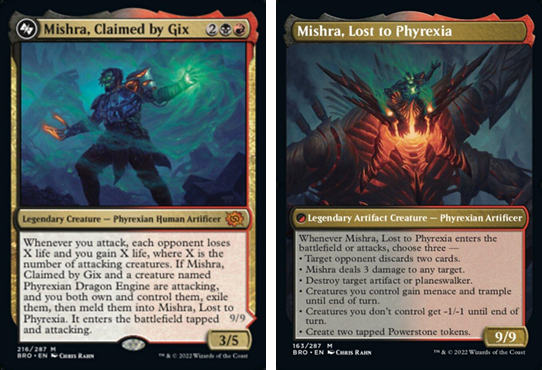
Mishra, Claimed by Gix is the card you play if you want access to the final form, Mishra, Lost to Phyrexia. At face value, it’s only okay, with a lifedrain trigger that isn’t really at home in Rakdos.
If you can pull off the Meld, you get Mishra, Lost to Phyrexia, which has enough text to rival Questing Beast. The juice is definitely worth the squeeze, with all of the abilities having relevancy at different points of the game. You should be able to pull this off in Rakdos with all of the tutors you have access to.
BROTHERS WAR: GREEN
Awaken the Woods is absolutely bonkers, and I both love and hate it in equal measure. I love it because it can trigger Emeria Shepherd a bunch of times, and I hate it because it can trigger all of the more obnoxious landfall abilities a bunch of times, too.
It’s at once a ritual and a game-winning spell, and I’m not sure how to feel until I see it in action. What I do know is that it’s hella good, and definitely worth picking up.
Bushwhack is power creep. You play this over Prey Upon. That’s… it.
I mentioned Austere Command earlier in this review. Austere Command sees so much play because it gets rid of all artifacts and enchantments as one of the modes. Fade from History offers that mode for four mana, in green, with the low cost of giving players a largely forgettable 2/2.
Don’t let 1v1 Magic heuristics fool you — this card is highly playable despite giving a token to opponents. Hey, you might get one yourself, too.
Gaea’s Gift may be a whole mana more than the likes of Tamiyo’s Safekeeping, but I’d argue it’s well worth it. In a similar vein to Akroma’s Will, this thing can let you be aggressive or defensive, and that kind of flexibility is worth a lot in EDH.
Every time I read Gwenna, Eyes of Gaea, I have to read it again. It does elf-things, sure, but it does them in an off-kilter way.
I want to say this card is good, or even great. It’s an enabler as much as it is a mana dork. Somebody with more energy than me will find a way to break this eventually.
Speaking of breaking things, Sarinth Steelseeker kinda breaks treasure. I’m still weirded out by green having so much access to treasure, if I’m being perfectly honest.
Pair this scout with Old Gnawbone, Tireless Provisioner, or any number of ways to grind out artifacts and you basically have a way to churn through your library.
While Shoot Down isn’t the most powerful card in the set, it’s an important milestone. Broken Wings, at instant speed, for three mana was a step above Return to the Earth. And Shoot Down is, too — just in another direction. Give it another couple years and we’ll have Broken Wings that exiles, and it’ll be a step too far.
Titania, Voice of Gaea, alone, is pretty OK. She blocks like a champ and gains you plenty of life for being in that archetype.
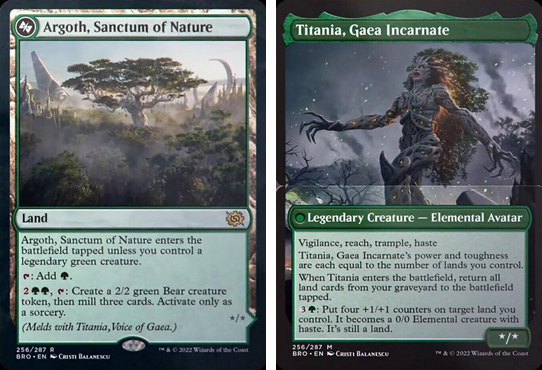
Argoth, Sanctum of Nature is also pretty good. Repeatable self-mill that makes blockers is always nice.
Titania, Gaea Incarnate is the Meld reward — and honestly? She’s really, really good. Splendid Reclamation alongside everything else this card does is game-winning. Of the Meld cards, I think Titania sees the most play in the 99, and not just because she’s mono-colored.
Caustic Caterpillar didn’t need to be outclassed by a mostly-better, easier to cast variant, but here’s Haywire Mite anyway.
Not being able to hit creatures is honestly not a big deal; exiling problem pieces, however, is a big deal. Coupled with the cost reduction and we have a winner — one of the most impactful cards in the set.
There are now many ways to play lands from the graveyard, at various mana costs. Perennial Behemoth is the first that can recur itself, but for a Perennial, it’s remarkably short lived.
It’s a lot cheaper than Crucible of Worlds, and that’s the main draw.
BROTHERS WAR: MULTICOLOR
The multicolor offerings in this set are on the whole pretty attractive. Battery Bearer kicks us off, turning your creatures into Powerstones and coming bundled with some card draw, too. Simic artifacts is a lesser played deck, but this makes the cut every time.
I and many others have been enjoying five color legends recently, whether using Sisay, Weatherlight Captain or Jodah, the Unifier. Hajar, Loyal Bodyguard fits in both and offers a nice way to keep your board intact.
I like it in Sisay, especially, because it grants two colors on curve. Is it better than Linvala, Shield of Seagate? Eh, you probably run both.
Harbin, Vanguard Aviator is a cheap way to convert your token army into player-killing potential. He’s one of the better options in the Command zone for a soldier tribal UW deck, too.
Hero of the Dunes just reminds me of Alesha. Unfortunately, she’s a little too powerful for Alesha to bring back. She’s still a solid card, though, and one I’m excited to play in many decks, ranging from Human tribal to a low to the ground Orzhov aristocrats outfit.
Legions to Ashes is kinda like Maelstrom Pulse, but a little narrower. It’s also a much needed balance to all of the decks wanting to make nonlegendary token copies of powerful creatures. I like that it exists, and in certain metagames, it’ll overperform.
Mishra, Tamer of Mak Fawa is one of the most exciting looking Commanders in the set. Giving all of your permanents “Ward – Sacrifice a Permanent.” is like having a suped up Karmic Justice on the field.
Being able to Unearth all of your artifacts is likewise a powerful ability, and sticking both on one card makes for an attractive combo. Once you see this in action, you’ll come around to it pretty quickly if you haven’t already.
Queen Kayla bin-Kroog joins Osgir and co in the latest line of cool and interesting Boros Commanders. Mass recursion is always great, and the Queen will find a home in just as many decks as she helms.
Saheeli, Filigree Master is worth mentioning just because of how easy it is to get an emblem out of her. For this reason alone, she’s worth playing — kinda like Sorin, Lord of Innistrad.
Sarinth Greatwurm makes a Powerstone when anybody has a land enter the battlefield — it’s true. That counts Field of Ruin and opponents playing lands for turn.
The ultimate question when building around Powerstones is balancing the producers vs the payoffs. This card isn’t a hard one to evaluate, though. It’s going in.
Skyfisher Spider is basically always going to destroy something in the right deck, and that’s a powerful EtB ability to have access to. Gaining you life on the way out can be the difference between winning and losing a game, so I’d definitely check it out.
Simic gets interesting Commanders now, and Tawnos, the Toymaker is another that gives a unique gameplay experience. This one will be popular because of how it’s both open ended and prescribed. It’s powerful, too, which certainly helps.
Third Path Iconoclast is another token maker for spellslinging decks, but it also makes artifacts, and triggers from casting them. I can see certain decks dropping the less efficient and less synergistic token makers for this one instead.
Finally, a Bant Commander that doesn’t care about flickering. Tocasia, Dig Site Mentor is a weird graveyard focused Bant Commander, exploring similar space to the Abzan and Mardu decks that care about Legendary.
In Tocasia’s case, she cares more about artifacts.
If BRO does one thing right, it’s offering us cool Commanders in colors that have historically been stagnant. Urza, Lord Protector makes me want to play Azorius, and it’s a cinch to get The Mightstone and Weakstone into play in those colors too (a card that’s gonna be great for colorless decks, like Kozilek, to be sure).
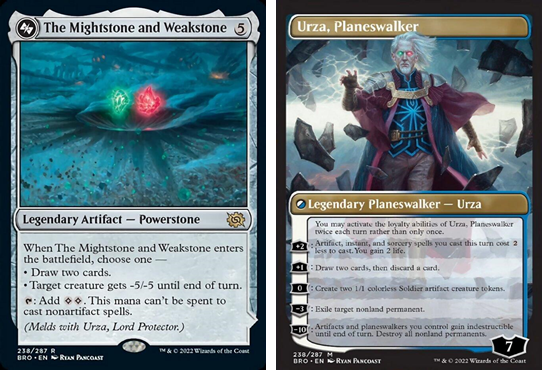
Urza, Planeswalker is the reward, and it’s a good one. One of the best. Just read it. The card speaks for itself.
Bladecoil Serpent offers a new late-game mana sink for Grixis decks. It’s actually surprisingly flexible, and one I’d be excited to try out.
BROTHERS WAR: THE REST
Liberator, Urza’s Battlethopter is utterly fabulous, in an indulgent kind of way. Art aside, it’s a solid upgrade to Shimmer Myr. You run both, obviously.
The kinds of decks that are running Portal to Phyrexia are never hard casting it. That’s the main difference between high end artifacts and enchantments, really. I wanna weld this thing in and out of the graveyard so bad.
Slagstone Refinery is kinda like adding the salt in during the cooking process. You don’t realize it, but it’s adding a lot to the dish.
Cards like this, which make tapped mana sources, are definitively seasoning. They’re designed to augment your deck — not be built around.
Thran Power Suit is sweet. It might lack the pure punchiness of Blackblade Reforged or Colossus Hammer, but it scales well and eventually beats both for ease of equipping and upside. Ward (2) is attractive to these kinds of decks.
Demolition Field solves one of the main problems with Field of Ruin — giving up to two other players a free resource. Field of Ruin still has a place, sure, but Demolition Field is set to replace it in most decks.
Tocasia’s Dig Site is a slam dunk for Surveil decks, sure. But even then, it’s not those decks solely that want it. Controllable self mill is powerful, and this land enables it.
Rescue Retriever is one of the cards from Set Boosters that is worth a second look. While the creature typing of Dog Soldier unfortunately evokes far more grisly imagery than this adorable, good boy, it’s startlingly relevant.
Soldier decks want this, and so do tribal tribal decks. I go on about tribal tribal quite often, but really, there’s never been a better time to build it.
We’ve reached the end of the review, and to have gotten here, you’d have to be a real Geology Enthusiast. Our final card today, Geology Enthusiast, makes free mana every one of your end steps. It’s nothing big or fancy, but it gets the job done, and it draws cards as a mana sink.
END STEP
Whew, thanks for joining me for this set review. The Brothers’ War is a brilliant set from the perspective of a Commander player, and I can’t wait to dig in and make a few upgrades to my decks. Let me know what you’re going to brew with on Twitter!

Kristen is Card Kingdom’s Head Writer and a member of the Commander Format Panel. Formerly a competitive Pokémon TCG grinder, she has been playing Magic since Shadows Over Innistrad, which in her opinion, was a great set to start with. When she’s not taking names with Equipment and Aggro strategies in Commander, she loves to play any form of Limited.

